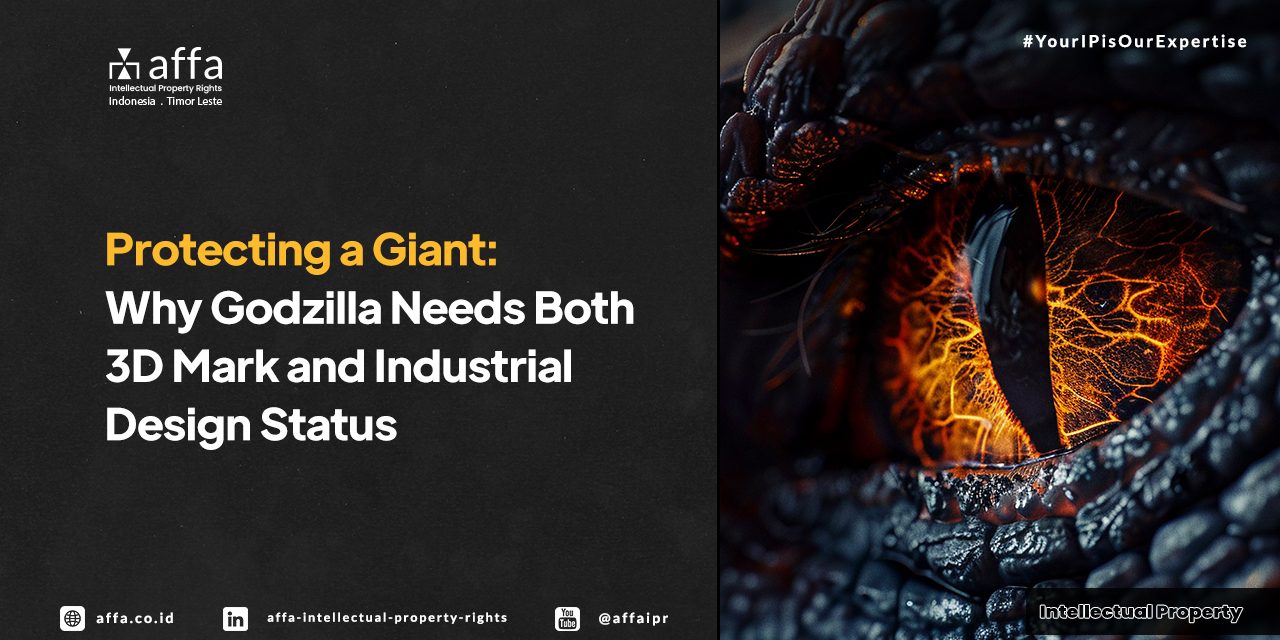This November, one of Japan’s oldest Intellectual Property (IP) assets celebrates its 70th anniversary. First introduced as a movie in 1954, Godzilla has since starred in over 40 films and animated series, and its Trademark is protected in more than 30 countries worldwide.
As a giant mutant lizard with many variations, its likeness has also been immortalized in various toys and merchandise, often registered as Industrial Designs to protect them from counterfeiting. However, since Industrial Design protection has a limited duration, Toho, the owner of Godzilla’s IP, has also registered it as a 3D Mark.
What’s the difference? What are the advantages compared to Industrial Designs?
Here’s the answer…
Aesthetic Value vs. Distinctiveness
Based on its definition, Industrial Design protects the aesthetic aspects or appearance of a product, such as its shape, pattern, or configuration, which give it a distinctive impression. The focus is on visually appealing elements rather than brand identity. Therefore, Industrial Designs protect the unique design of vehicles, household appliances, and, of course, toys.
On the other hand, a 3D Mark is a mark that protects the three-dimensional shape of a product used to distinguish the goods or services of one party from another. Examples include the Coca-Cola bottle, Lego bricks, Ferrari’s prancing horse, and the PS5 console.
The differences, as well as the advantages and disadvantages of Industrial Designs and 3D Marks, can be summarized in the following table:
| Industrial Design | 3D Mark | |
| Focus of Protection | Protects the aesthetics or visual appeal of a product. | Protects the identity and function of a Trademark in commerce. |
| Duration of Protection | Limited duration, typically 10-15 years, depending on the regulations in a given country. | Unlimited duration as long as it is renewed periodically every 10 years. |
| Registration Process & Criteria | Must be new and unique in its design. | Requires evidence that the shape has a distinctive character and is recognized by consumers as a Trademark.
A 3D Mark cannot be registered if the shape has functional value. |
| Advantages | The registration process is relatively simpler and quicker. | Protection can last indefinitely with periodic renewals. |
| Disadvantages | Protection is limited to aesthetic aspects, and the duration cannot be extended. | The registration process is more complex and requires significant evidence of use to demonstrate distinctiveness in the market. |
Godzilla Needs Longer Protection
From the table above, we can understand why IP assets as old as Godzilla still seek longer protection. Especially considering the increasing hype surrounding Godzilla after winning the 2024 Academy Award/Oscar for Best Visual Effects. This success could lead to an increase in counterfeit products and toys by irresponsible parties.
According to Yahoo Japan and a decision by the Japanese court, Toho’s attempt to register one of Godzilla’s variants, Shin Godzilla, as a 3D Trademark began as early as October 2019. However, after a lengthy process, the Japan Patent Office (JPO) issued a final rejection in March 2024, stating that the registered Godzilla shape was too generic and lacked sufficient distinctiveness.
Toho subsequently filed an appeal in May, emphasizing that the Shin Godzilla design has a strong distinctive character and is widely recognized by the public. This was followed by a review of submitted evidence, including the popularity of Shin Godzilla as a character, its use in various products, and public recognition of the shape as a unique identity, by the court.
 3D Mark Shin Godzilla – Application No.: 2020-120003
3D Mark Shin Godzilla – Application No.: 2020-120003
Finally, on October 30, 2024, the court overturned the JPO’s decision and declared that the 3D shape of Shin Godzilla possesses sufficient distinctiveness and is eligible to be registered as a 3D Mark. The court emphasized that the popularity and widespread recognition of the Shin Godzilla character added significant value to the assessment of its distinctiveness.
As a result, Shin Godzilla has successfully secured the opportunity to get unlimited protection.
This ruling sets an important precedent for 3D Mark protection in Japan, particularly for the entertainment industry and consumer products that rely on unique characters or designs as their brand identity. Previously, iconic characters were typically protected through copyright for creative works, and their names or logos as Trademarks. Now, these characters can also be protected as 3D Marks if proven to have distinctiveness and public recognition as a source identifier.
This strengthens Intellectual Property protection for iconic characters through a layered and complementary approach, depending on the context of their use.
Should you need further information regarding trademark registration and protection in Indonesia or worldwide, please contact us via email: [email protected].







